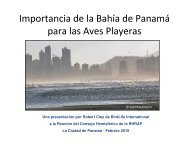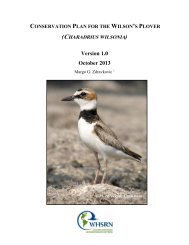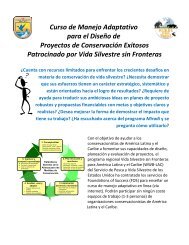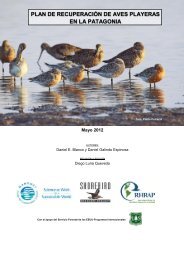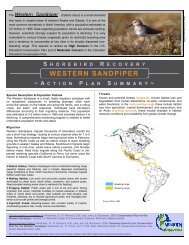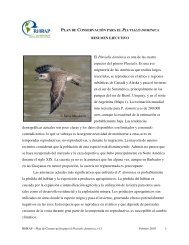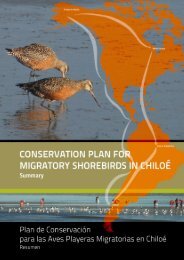Sanderling Plan - Western Hemisphere Shorebird Reserve Network
Sanderling Plan - Western Hemisphere Shorebird Reserve Network
Sanderling Plan - Western Hemisphere Shorebird Reserve Network
You also want an ePaper? Increase the reach of your titles
YUMPU automatically turns print PDFs into web optimized ePapers that Google loves.
mindedness against the opposing viewpoint, resolvable only through regulatory measures.<br />
However, such an approach will not work over the long run, because it does not change people’s<br />
values or will; it only holds the tide at bay, while further dividing stakeholders. Although in<br />
many cases imposed enforcement may turn out to be the necessary immediate path forward, in<br />
many other cases (or over the long run), the situation will improve under an approach that treats<br />
each local challenge as an opportunity for creative problem-solving based on shared principles<br />
and values. For example, State Wildlife Action <strong>Plan</strong>s frame the issue of listing endangered<br />
species as an outcome that no one wants; it is costly in time and money, and it imposes<br />
restrictions on landowners. Given that no one wants that outcome, what innovative<br />
collaborations between the government, private agencies, and landowners might we come up<br />
with to prevent declining species from entering that (unwanted) category? The result has been<br />
powerful and effective; the public wants to do the right thing, creative solutions are exciting and<br />
meaningful to be a part of, and meanwhile, the wildlife—and the public—benefit.<br />
A similarly creative approach is being employed to resolve competing shorebird and<br />
agriculture needs for water/wetlands in the Pacific Northwest. Spearheaded by the U.S. Fish and<br />
Wildlife Service, The Nature Conservancy, and other partners, the two projects are seeking to<br />
provide alternative habitats for shorebirds while offering benefits to farmers. The Walking<br />
Wetlands project in the Klamath Basin (Oregon/California; U.S. Fish and Wildlife Service), and<br />
the Farming For Wildlife project in the Skagit Valley (Washington; The Nature Conservancy)<br />
are such examples. In the Skagit Valley, The Nature Conservancy leases fields from farmers for<br />
3 years on a rotating basis, during which time the leased fields are flooded with constant sheet<br />
water (5–10 centimeters deep) to benefit shorebirds. The flooded fields have successfully<br />
attracted tens of thousands of migrating and wintering shorebirds, while reducing pesticide,<br />
herbicide, and fertilizer inputs to the watershed. Farmers are compensated in the short-term (via<br />
the leasing fee), and benefit in the long-term: the fields have much higher crop yields, have 40%<br />
higher nutrients, fewer weeds, and 95% less disease after the 3-year flooding cycle; also, farmers<br />
gain the additional benefit of the opportunity to enter the elite organic market (as organic<br />
certification requires 3 years without pesticides). This project has grown quickly (more than<br />
6,000 acres now participate in the Klamath) and has gained wide support among farmers. These<br />
projects provide several important lessons: 1) wetlands and agricultural lands can be integrated<br />
in ways that maintain ecological integrity as well as the economic well-being and sustainability<br />
WHSRN – <strong>Sanderling</strong> Conservation <strong>Plan</strong>, February 2010, v1.1 50




